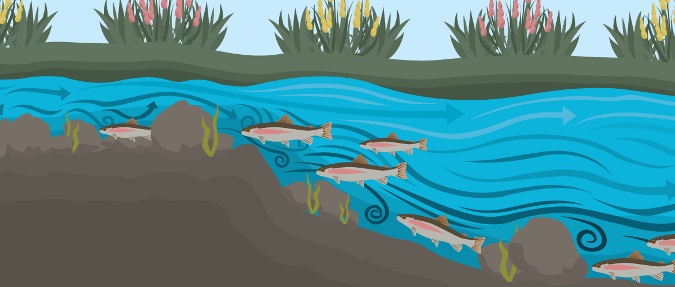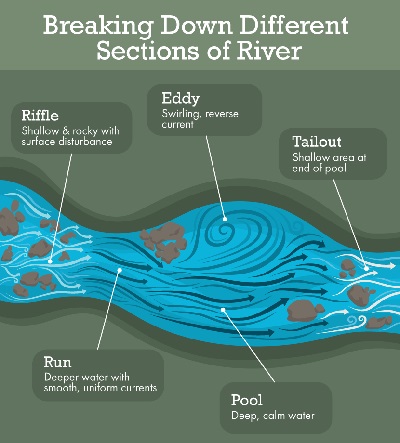While you might get lucky pulling up to any old spot at a river and throwing a line, learning the areas trout prefer in a stream will increase your chances of catching fish. To understand where to find trout in a river at any given time, it is important to have a basic idea of how trout behave and why they relate to certain areas in the river.
Stream-dwelling trout have a few basic needs:
Oxygen: Trout need to breathe in order to live. In a river you will generally find trout close to current where the water is more oxygenated. Avoid large stretches of stagnant water.
Food: Trout need to eat and will seldom stray far from a food source. Find the food and you will find the fish.
Shelter and Rest: Trout like to be near current, but they are also quite lazy. They like to find objects to rest behind, and other areas where they can sit outside the main flow. They also need a place to hide from predators. This can be the same structure that blocks the current, or it might be overhead shelter like a tree or bush. Bonus points if the area has quick access to deeper water.
Keeping these elements in mind, you can closely examine the stream environment to find some fish.
When approaching a river for the first time, it is easy to become intimidated by the sheer amoun
t of water. Before making your first cast, you should take a moment to “read” the water. This is the process of examining the stream above and below the surface and breaking it down into manageable sections where fish will likely be. Follow almost any stream as it carves its way through the landscape and you will notice a pattern of characteristics. Learn to identify these patterns and you can use them to help locate trout.
Sections of a River
Riffle: A riffle is a rocky, shallow area in a stream where water cascading over rocks creates a noticeable surface disturbance. To identify a riffle, look for a choppy surface or 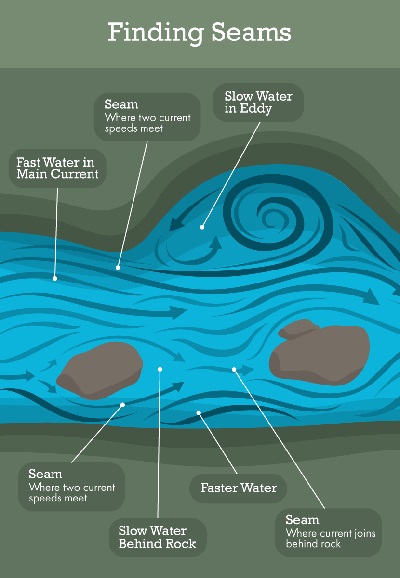 whitewater spilling over shallow rocks into deeper water. A good riffle will fulfill all of the basic needs of a trout. The shallow, highly oxygenated water is a perfect environment for the aquatic insects trout eat. Boulders and rocks create plentiful hiding and resting spots. Deeper water downstream gives trout rest and security. All of these aspects make a riffle a great starting point when looking for trout.
whitewater spilling over shallow rocks into deeper water. A good riffle will fulfill all of the basic needs of a trout. The shallow, highly oxygenated water is a perfect environment for the aquatic insects trout eat. Boulders and rocks create plentiful hiding and resting spots. Deeper water downstream gives trout rest and security. All of these aspects make a riffle a great starting point when looking for trout.
Run: A run is an in-between zone directly below a riffle, where the water becomes deeper and the current is more uniform. Aside from a riffle, a run is one of the top places to look for trout in a stream. Trout like the shelter provided by deeper water and the proximity to an easy meal. Fish often suspend at the edge of the current or lie along the bottom eating insects that are carried downstream out of a riffle.
Pool: A pool is the deepest portion of any given section of river with the slowest current. Fish will often retreat to a pool on bright, sunny days or if they feel threatened. In shallow streams, pools might be the only areas that hold fish, but it is different for larger rivers. While most river trout – especially big ones – may spend a portion of their day in a pool, typically this is when they are least active.
Eddy: An eddy is an area of the river where structure such as an indent in the riverbank, a log, or a large boulder blocks the current flow and influences its direction. Directly downstream of the object, a pocket of swirling water will form opposite the main direction of current flow. Trout love eddies because they funnel and trap insects drifting by in the current. Look for foam or bubbles collecting on the surface where the main current meets up with the swirling water and place your casts there.
Tailout: A tailout is a shallow, flat section at the end of a pool before the water spills over into another riffle. Where the water becomes shallow, a natural funnel is formed that brings anything drifting downstream right to the fish. Trout will often wait in a tailout and sip hatching insects off the surface as they float by, so it is a good spot to look for rising fish.
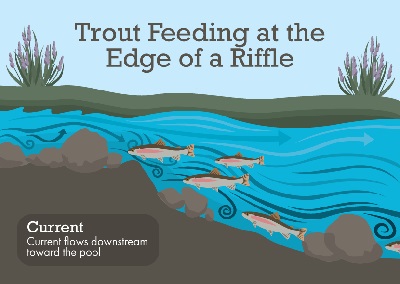 Examining the
Examining the
Structure
Learning to pinpoint structure in different sections of a river is the final step to reading water like a pro and increasing your likelihood of finding trout. Structure can refer to objects in and around the river such as boulders, gravel bars, holes, and changes in bottom contour. Less obvious examples are eddies and current seams created by the river flow, or shade from a high bank. A good section of river might contain several of these features, and as a rule, areas where different types of structures intersect are prime locations to look for trout.
Boulders, logs, and other obstructions: Any object that impedes the current flow is worth investigating. It’s worth bonus points if it is located in a favorable section of the river such as a riffle, run, or tailout. Multiple casts placed upstream, to the side, and downstream of the object will give you a shot at any fish that may be sitting there.
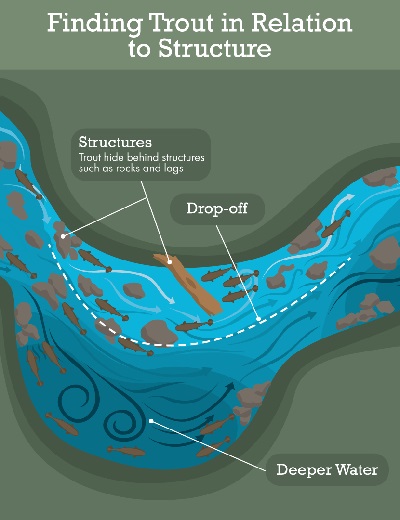 Changes in the river: Bends, gravel bars, shelves, holes, and other changes in the river or bottom contour are great places to look for trout. A good example is the area right where a riffle drops into deeper water. Trout will often rest in the slower current below the drop-off, eating insects that are swept over the edge.
Changes in the river: Bends, gravel bars, shelves, holes, and other changes in the river or bottom contour are great places to look for trout. A good example is the area right where a riffle drops into deeper water. Trout will often rest in the slower current below the drop-off, eating insects that are swept over the edge.
Other good locations are the insides of river bends, points jutting into the current, and indentations along the bank. A good pair of polarized sunglasses can help locate structure hidden below the surface. Dark areas often signify deeper holes. Look for gravel bars mid-river, and drop-offs or shelves at the river’s edge where the current begins to slow. Fish will be resting and feeding on the deeper side of these areas.
Seams
A “seam” is any spot where two currents converge. Trout like seams because the joining currents create feeding lanes that collect drifting food, so when looking at any structure in a river it is important to locate any associated seams. With some experience you will be able to detect seams as subtle lines along the surface where slower current meets with fast. Watch the current carefully as it flows over and around structure. Look for bubble trails floating downstream or any area where there is a noticeable difference in current speed.
Next time you head to the river, spend a few minutes reading the water before making a cast. Pick out a section and decide which structure you are going to target. Of course, experience is the key to success, so get out as much as possible and practice these tips. When you do catch a fish try to remember the key features of the area you were fishing. Eventually it will seem like less of an exercise, and reading the water will become an intuitive skill that will lead you to more fish.

